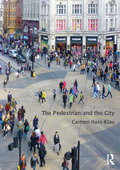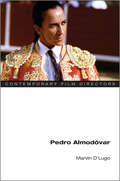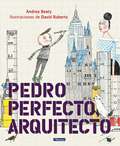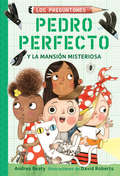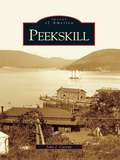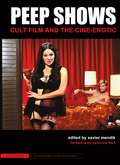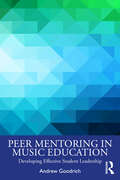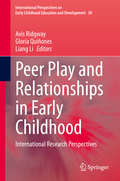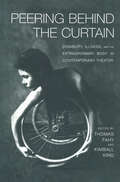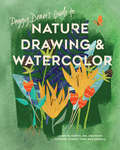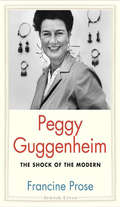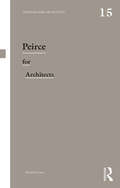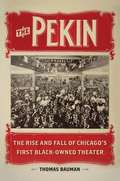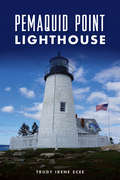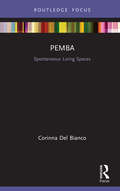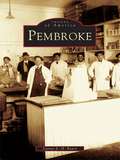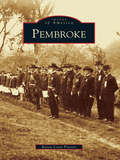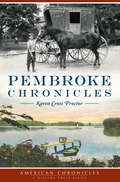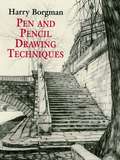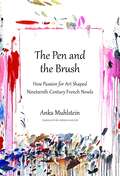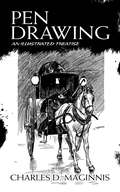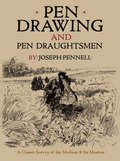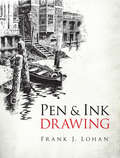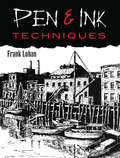- Table View
- List View
The Pedestrian and the City
by Carmen Hass-KlauThe Pedestrian and the City provides an overview and insight into the development, politics and policies on walking and pedestrians: it includes the evolution of pedestrian-friendly housing estates in the 19th century up to the present day. Key issues addressed include the struggle of pedestrianization in town centers, the attempts to create independent pedestrian footpaths and the popularity of traffic calming as a powerful policy for reducing pedestrian accidents. Hass-Klau also covers the wider aspects of urban and transport planning, especially public transport, essential for promoting a pedestrian-friendly environment. The book includes pedestrian-friendly policies and guidelines from a number of European countries and includes case studies from the UK, Germany, Britain, France, Spain, Italy, the Netherlands, Denmark, the US and Canada, with further examples from ten additional countries. It also contains a unique collection of original photographs; including ‘before’ and ‘after’ photos of newly introduced pedestrian-friendly transport policies. As the pedestrian environment has become ever more crucial for the future of our cities, the book will be invaluable to students and practicing planners, geographers, transport engineers and local government officers.
Pedro Almodóvar (Contemporary Film Directors)
by Marvin D'LugoPerhaps the best-known Spanish filmmaker to international audiences, Pedro Almodóvar gained the widespread attention of English-speaking critics and fans with the Oscar-nominated Women on the Verge of a Nervous Breakdown and the celebrated dark comedy Tie Me Up! Tie Me Down!. Marvin D'Lugo offers a concise, informed, and insightful commentary on a preeminent force in modern cinema. D'Lugo follows Almodóvar's career chronologically, tracing the director's works and their increasing complexity in terms of theme and the Spanish film tradition. Drawing on a wide range of critical sources, D'Lugo explores Almodóvar's use of melodrama and Hollywood genre film, his self-invention as a filmmaker, and his on-screen sexual politics. D'Lugo also discusses what he calls "geocultural positioning," that is, Almodóvar's paradoxical ability to use his marginal positions—in terms of his class, geographical origin, and identity—to develop an expressive language that is emotionally recognizable by audiences worldwide. Two fascinating interviews with the director round out the volume. An exciting consideration of an arthouse giant, Pedro Almodóvar mixes original interpretations into an analysis sure to reward film students and specialists alike.
Pedro Perfecto, Arquitecto (Los Preguntones)
by Andrea BeatyPero poca gente apreció su talento, en especial su maestra de segundo grado, la señorita Eva Delgado, que prohibió la arquitectura y los edificios de gran altura. A Pedro se le cayó el mundo a los pies y perdió todo interés… Hasta que, en una fatídica excursión, demostró lo práctica que puede ser una gran construcción.
Pedro Perfecto y la mansión misteriosa
by Andrea BeatyPedro Perfecto es un arquitecto en su esencia: cuando no está haciendo casas con comida, su cabeza está en las nubes, soñando con el diseño. Así que queda totalmente impresionado cuando la tía Bernice de Ada Twist hereda una vieja casa del magnate de los helados Herbert Sherbert que está llena de innumerables habitaciones de todos sus períodos arquitectónicos favoritos. Pero algo no anda bien. . . Todo el mundo dice que la casa está embrujada, y parece que varias antigüedades con un valor incalculable, que supuestamente ayudarían a la tía Bernice a pagar el mantenimiento de la casa, han desaparecido. Si no pueden encontrar esas antigüedades, la tía Bernice podría perder la casa para siempre. ¡Se necesitarán todos los conocimientos de arquitectura de Pedro y la ayuda de los otros interrogadores, Rosie Revere, Ada Twist y Sofia Valdez, para resolver el misterio y encontrar el tesoro!
Peekskill: A Hudson Valley Community's Untold Story (Images of America)
by John J. CurranPeekskill portrays the history of a small Dutch-style village that grew into a prosperous factory city, with scenic vistas that have always been a particular delight for photographers. Using many of the resulting photographs, Peekskill displays this delightful place, nestled into three surrounding hills where the Hudson River spreads into Peekskill Bay, approaching the Bear Mountain highlands. Peekskill also presents the prominent people of this community, who include Joseph Binney, owner of the company that later became the maker of Crayola products; Chauncey Depew, keynote speaker at the 1886 dedication of the Statue of Liberty; and George Pataki, governor of New York State.
Peep Shows: Cult Film and the Cine-Erotic (AlterImage)
by Xavier MendikFrom mediations on explicit imagery and profiles of prominent performers to discussions of national nudities and the titillating thrills of new technologies, cine-erotica has become a significant and subversive category of contemporary film, media, and cultural studies. Expanding on recent work in gender, cultural, and audience-based studies, Peep Shows: Cult Film and the Cine-Erotic examines the global traditions of cult erotica, explaining key patterns, paradigms, and performers from the world of cult celluloid sexuality. Peep Shows includes profiles of porn performers and icons such as Ron Jeremy, Betty Page, Catherine Breillat, and Joe D'Amato. Essays also provides case studies of contemporary porn parodies, lesbian erotica, Japanese Pink porn cinema, Café Flesh, the Seduction cinema label, the dominatrix in erotic cinema, female porn viewers, burlesque cinema programming, and porno chic soundtracks. The volume features exclusive interviews with erotic performers Seka, Buck Angel, Misty Mundae, Christina 'Thriller' Lindberg, and the prolific porn producer, Michael L. Raso.* Cover image from VIVA © 2007 by Anna Biller
Peep Shows: Cult Film and the Cine-Erotic
by Xavier MendikExpanding on recent work in gender, cultural, and audience-based studies, Peep Shows: Cult Film and the Cine-Erotic examines the global traditions of cult erotica, explaining key patterns, paradigms, and performers from the world of cult celluloid sexuality.
Peer Mentoring in Music Education: Developing Effective Student Leadership
by Andrew GoodrichPeer Mentoring in Music Education: Developing Effective Student Leadership offers a practical guide to peer mentoring in music education, enabling music teachers to implement and benefit from this technique with their students. Drawing on extensive and current research in education and music education, the core focus of this book is on the instructional practice of peer mentoring and how students can become effective leaders. Through case studies and examples focused on music education, the author shows how peer mentoring can transform learning for all students and foster student leadership as part of a student-centered instructional approach. Part I explores the foundations of these instructional practices, the role of the music teacher, the role of the student, and how socializing and student leadership contribute to meaningful learning. Part II portrays stories of four exemplary music teachers who use peer mentoring and student leadership in their music programs across a wide array of age levels and music classes and ensembles. Music teachers will benefit from learning about the transformative power of peer mentoring and student leadership, and how these instructional practices aid with diversity, equity, inclusion, and access so that all students are valued in the music class and ensemble. Peer Mentoring in Music Education: Developing Effective Student Leadership provides a comprehensive guide for in-service and preservice music teachers seeking to understand peer mentoring and incorporate this technique in teaching.
Peer Play and Relationships in Early Childhood: International Research Perspectives (International Perspectives on Early Childhood Education and Development #30)
by Avis Ridgway Gloria Quiñones Liang LiThis book offers a rich collection of international research narratives that reveal the qualities and value of peer play. It presents new understandings of peer play and relationships in chapters drawn from richly varied contexts that involve sibling play, collaborative peer play, and joint play with adults. The book explores social strategies such as cooperation, negotiation, playing with rules, expressing empathy, and sharing imaginary emotional peer play experiences. Its reconceptualization of peer play and relationships promotes new thinking on children's development in contemporary worlds. It shows how new knowledge generated about young children's play with peers illuminates how they learn and develop within and across communities, families, and educational settings in diverse cultural contexts. The book addresses issues that are relevant for parents, early years' professionals and academics, including the role of play in learning at school, the role of adults in self-initiated play, and the long-term impact of early friendships. The book makes clear how recent cultural differences involve digital, engineering and imaginary peer play. The book follows a clear line of argument highlighting the importance of play-based learning and stress the importance of further knowledge of children's interaction in their context. This book aims to highlight the narration of peer play, mostly leaning on a sociocultural theoretical perspective, where many chapters have a cultural-historical theoretical frame and highlight children's social situation of development. Polly Björk-Willén, Linköping University, Sweden
Peering Behind the Curtain: Disability, Illness, and the Extraordinary Body in Contemporary Theatre (Studies in Modern Drama #18)
by Thomas Fahy Kimball KingFirst Published in 2002. Routledge is an imprint of Taylor & Francis, an informa company.
Peggy Dean's Guide to Nature Drawing and Watercolor: Learn to Sketch, Ink, and Paint Flowers, Plants, Trees, and Animals
by Peggy DeanThis fun and easy-to-use nature drawing and watercolor guide is perfect for anyone inspired by nature to draw, doodle, ink, and paint colorful flora and fauna. Artist, author, and popular art instructor Peggy Dean presents this nature drawing guide that teaches you how to master drawing and watercolor techniques from sketching and shading to washes and blending. With Peggy's easy and energetic lessons, absolutely anyone--regardless of ability--can learn to draw the natural world. Beginning with delicate cherry blossoms, wildflowers, and lacy ferns, lessons build to composing stunning bouquets of flowers and majestic landscapes. You'll also discover how to draw animals such as colorful fish and birds in flight, as well as mammals like stoic camels and the mighty polar bear. Through the lessons on technique combined with clear, detailed instructions, you'll gain the expertise and confidence that will allow you to quickly build your skills, discover your own personal style, and achieve beautiful botanical and animal illustrations.
Peggy Guggenheim
by Francine ProseOne of twentieth-century America's most influential patrons of the arts, Peggy Guggenheim (1898-1979) brought to wide public attention the work of such modern masters as Jackson Pollock and Man Ray. In her time, there was no stronger advocate for the groundbreaking and the avant-garde. Her midtown gallery was the acknowledged center of the postwar New York art scene, and her museum on the Grand Canal in Venice remains one of the world's great collections of modern art. Yet as renowned as she was for the art and artists she so tirelessly championed, Guggenheim was equally famous for her unconventional personal life, and for her ironic, playful desire to shock. Acclaimed best-selling author Francine Prose offers a singular reading of Guggenheim's life that will enthrall enthusiasts of twentieth-century art, as well as anyone interested in American and European culture and the interrelationships between them. The lively and insightful narrative follows Guggenheim through virtually every aspect of her extraordinary life, from her unique collecting habits and paradigm-changing discoveries, to her celebrity friendships, failed marriages, and scandalous affairs, and Prose delivers a colorful portrait of a defiantly uncompromising woman who maintained a powerful upper hand in a male-dominated world. Prose also explores the ways in which Guggenheim's image was filtered through the lens of insidious antisemitism.
Peirce for Architects (Thinkers for Architects)
by Richard CoyneIdeas gain legitimacy as they are put to some practical use. A study of Charles Sanders Peirce (1839-1914) supports this pragmatism as a way of thinking about truth and meaning. Architecture has a strong pragmatic strand, not least as we think of building users, architecture as a practice, the practical demands of building, and utility. After all, Vitruvius placed firmness and delight in the company of utilitas amongst his demands on architecture. Peirce (pronounced 'purse') was a logician, and so many of his ideas are couched in terms of formal propositions and their limitations. His work appeals therefore to many architects grappling with the digital age, and references to his work cropped up in the Design Methods Movement that developed and grew from the 1950s. That movement sought to systematise the design process, contributing to the idea of the RIBA Plan of Work, computer-aided design, and various controversies about rendering the design process transparent and open to scrutiny. Peirce’s commitment to logic led him to investigate the basic elements of logical statements, notably the element of the sign. His best-known contribution to design revolves around his intricate theory of semiotics, the science of signs. The study of semiotics divided around the 1980s between advocates of Peirce’s semiotics, and the broader, more politically charged field of structuralism. The latter has held sway in architectural discourse since the 1980s. Why this happened and what we gain by reviving a Peircean semiotics is the task of this book.
The Pekin: The Rise and Fall of Chicago's First Black-Owned Theater
by Thomas BaumanIn 1904, political operator and gambling boss Robert T. Motts opened the Pekin Theater in Chicago. Dubbed the "Temple of Music," the Pekin became one of the country's most prestigious African American cultural institutions, renowned for its all-black stock company and school for actors, an orchestra able to play ragtime and opera with equal brilliance, and a repertoire of original musical comedies. A missing chapter in African American theatrical history, Bauman's saga presents how Motts used his entrepreneurial acumen to create a successful black-owned enterprise. Concentrating on institutional history, Bauman explores the Pekin's philosophy of hiring only African American staff, its embrace of multi-racial upper class audiences, and its ready assumption of roles as diverse as community center, social club, and fundraising instrument. The Pekin's prestige and profitability faltered after Motts' death in 1911 as his heirs lacked his savvy, and African American elites turned away from pure entertainment in favor of spiritual uplift. But, as Bauman shows, the theater had already opened the door to a new dynamic of both intra- and inter-racial theater-going and showed the ways a success, like the Pekin, had a positive economic and social impact on the surrounding community.
Pemaquid Point Lighthouse (Landmarks)
by Trudy Irene SceePemaquid Point Lighthouse was first constructed in 1827 and still sends its beam out seventy-nine feet above sea level. Light keepers kept the lanterns burning from the 1820s through the 1930s, but they could not prevent every tragedy. Ships have crashed on the rocky shoals, taking sailors to their watery graves, while many others have been swept off the rocks by the powerful surf. Despite advances in technology and automation, the shore around the light remains a dangerous place. Author and historian Trudy Irene Scee uncovers the fascinating story of this iconic Maine lighthouse, its keepers and their families, from the construction of the first light through the present day.
Pemba: Spontaneous Living Spaces (Built Environment City Studies)
by Corinna Del BiancoPemba: Spontaneous Living Spaces looks at self-built dwellings and settlements in the case study city of Pemba in the Cabo Delgado region of Mozambique. Self-built houses born from need, in haste and with limited economical resources are often considered to be temporary structures but frequently become an integral part of the urban fabric, representative of a local culture of living. The study is part of the Spontaneous Living Spaces research project, and through a variety of documentation tools, it investigates the evolution of the architectural and urban elements that characterize self-built dwellings in Pemba. The evolution of the spontaneous living culture creates new forms of living in the city connected to local cultural expressions and the environment. These are placed in relation to the traditional and contemporary living cultures, settlement trends and the natural environment. Covering a history of housing in Mozambique and unpacking four settlement types in Pemba, this book is written for academics, professionals and researchers in architecture and planning with a particular interest in African architecture and urbanism.
Pembroke
by Lianne E. KearyBordered by three rivers, Pembroke is located just south of Concord in one of the fastest growing areas of the state. Like many towns in New England, Pembroke started out as an agricultural settlement and developed into a thriving mill town. Cotton cloth, paper, glass, and bricks were produced in the village's mills, mostly by French Canadian immigrant labor. Among other things, Pembroke is known as the residence of the reputed inventor of the revolver and the site of a grisly murder in 1875. Through vintage photographs, Pembroke chronicles the evolution of this New England town.
Pembroke (Images of America)
by Karen Cross ProctorIn the 1640s, Robert Barker and two companions canoed up the North River and turned onto one of the herring brooks, bringing Barker to the area where he eventually settled his family. Settlers from the coast soon began moving inland and small settlements sprang up. To incorporate the town of Pembroke in 1712, the First Church of Pembroke was established and a minister was settled. In the 18th and 19th centuries, Pembroke was defined by neighborhoods centering around eight district one-room schoolhouses. Each neighborhood had a distinct character, from the bustle of commerce in Bryantville, to the rural charm of Crookertown and Fosterville, to the shipbuilders, shoemakers, and iron founders in North Pembroke. The Bay Path, a main route from Boston to Plymouth, ran through the West Elm and High Street neighborhoods. Over the generations, these diverse and vibrant communities have helped to shape Pembroke into the town it is today.
Pembroke Chronicles (American Chronicles)
by Karen Cross ProctorIn its earliest days, Pembroke offered abundant fishing and lush forests for its Native American inhabitants. Starting in the 1640s, European colonists began turning the town from a farming community into a successful hub for shipbuilding. Pembroke's long history is colored by remarkable stories. Atop the old Pembroke Public Library rests a bee sculpture designed by Pembroke artist Richard Edlund, representing the spelling bees held each spring at the library since 1875. The Pembroke Monument Association first met in 1879 to discuss the purchase of a Civil War soldiers' monument for the town, yet it was nearly a decade before the monument was erected. In this collection of articles from her "Pembroke's Past" column, Karen Cross Proctor captures the spirit of the community.
Pen and Pencil Drawing Techniques (Dover Art Instruction)
by Harry BorgmanCompact but comprehensive, this manual contains the best information available on pencil and ink techniques. Written and beautifully illustrated by an acclaimed artist and advertising illustrator, it's the perfect companion for artists seeking a guide to the variety of techniques and media for rendering their ideas on paper.Pencil drawing and ink drawing receive separate treatments; both sections stress materials and tools -- including graphite pencils, charcoal and pastel pencils, wax pencils, pens, brushes, marking pens, scratching tools, and more. They also explore different methods of handling strokes and lines, techniques for stabling and conveying tones and shadows, and technical tips. The 28 step-by-step demonstrations -- many of them exquisitely illustrated in full color -- range from techniques of fine penwork and cross-hatching to drawing with colored inks and colored markers. In addition, a series of multipart exercises will prove extraordinarily useful to the student. The profusion of skillful illustrations throughout the book, over 540 in all, constitute a treasure in themselves, covering a great diversity of subjects -- from portraits and still lifes to landscapes and cityscapes worldwide.
The Pen and the Brush: How Passion for Art Shaped Nineteenth-Century French Novels
by Adriana Hunter Anka MuhlsteinA scintillating glimpse into the lives of acclaimed writers and artists and their inspiring, often surprising convergences, from the author of Monsieur Proust's Library With the wit and penetration well known to readers of Balzac's Omelette and Monsieur Proust's Library, Anka Muhlstein's PEN AND BRUSH revisits the delights of the French novel. This time she focuses on late 19th- and 20th-century writers--Balzac, Zola, Proust, Huysmans, and Maupassant--through the lens of their passionate involvement with the fine arts. She delves into the crucial role that painters play as characters in their novels, which she pairs with an exploration of the profound influence that painting exercised on the novelists' techniques, offering an intimate view of the intertwined worlds of painters and writers at the time. Muhlstein's deftly chosen vignettes bring to life a portrait of the nineteenth century's tight-knit artistic community, where Cézanne and Zola befriended each other as boys and Balzac yearned for the approval of Delacroix. She leads the reader on a journey of spontaneous discovery as she explores how a great painting can open a mind and spark creative fire.
Pen Drawing: An Illustrated Treatise
by Charles D. MaginnisStyle, materials, techniques, and values are the focus of this richly illustrated guide to pen drawing. In addition to proposing solutions for practical problems, the book offers advice on architectural and decorative drawing. More than 70 drawings by assorted artists range from tranquil churchyards and bustling city streets to striking posters. Many of the images are derived from The Century Magazine, Harper's Magazine, The Architectural Review, and other illustrated periodicals of the early twentieth century.Irish-American architect Charles D. Maginnis (1867-1955), a co-founder of the firm Maginnis & Walsh, was active in the design of ecclesiastical and campus buildings across the United States. He also served as President of the American Institute of Architects from 1937-39. Maginnis' practical guide to pen drawing features several of his own illustrations, created expressly for this instructive volume.
Pen Drawing and Pen Draughtsmen: A Classic Survey of the Medium and Its Masters (Dover Fine Art, History of Art)
by Joseph PennellIn this comprehensive study of the art of drawing with a pen, artist and author Joseph Pennell highlights his opinionated "technical suggestions" with more than 400 illustrations by 250 famous artists, including Titian, Dürer, Rembrandt, Rodin, Manet, Renoir, Beardsley, Pyle, Hiroshige, van Gogh, Rackham, and other masters from around the globe. Each of the high-quality reproductions is accompanied by a critique of its style and execution and occasional comparisons to the artist's other works and those of contemporaries. Featured images range from landscapes by Titian, Rembrandt, and Corot to figure studies by Dürer, Goya, and Rodin and portraits by Manet and Matisse. The tremendous variety of subjects extends to street scenes by Toulouse Lautrec and van Gogh, episodes from literature envisioned by Rossetti, Burne-Jones, and Millais, and decorations by Crane and Morris. A visual treasure trove and valuable reference, this volume will serve as an enduring source of instruction and inspiration for artists of all skill levels.
Pen & Ink Drawing (Dover Art Instruction)
by Frank J. LohanAn inspiring sourcebook for all skill levels, this guide helps artists discover a wide variety of subjects and ideas for their next sketch. More than 140 of the author's own drawings include partially finished details that illustrate how to achieve the desired visual effects. Stimulating topics include nostalgic scenes, old engravings, atmospheric effects, photographs, landscapes, and life itself.
Pen & Ink Techniques
by Frank J. LohanThis reader-friendly guide allows artists and would-be artists at all levels of achievement to experience the satisfaction of drawing with pen and ink techniques. Richly illustrated and containing dozens of simple exercises, it covers everything from the basic tools and materials to the production of advanced effects.A seasoned instructor, author Frank Lohan presents dozens of exercises for beginning, intermediate, and advanced artists. His topics range from the creation of hatching, tones, and stippling to dealing with the problems that can arise when adding texture, light, and shade. An extensive reference section features examples of landscapes, trees and foliage, flowers, faces, animals, and a wealth of other subjects. Helpful suggestions include tips for copying, reducing, and enlarging sketches; instructions for easy matting; and guidelines for reproducing sketches on greeting cards and notepaper.
